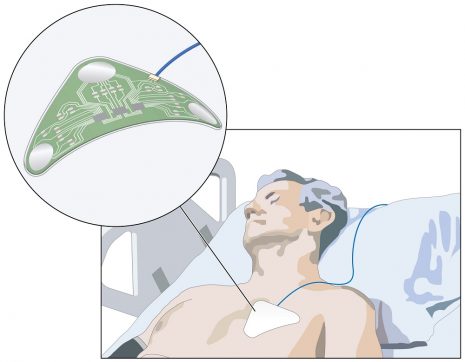The Future of Medical Diagnostics and Monitoring: Printed Sensors
 The ability to diagnose disease and monitor the body’s reaction to treatments is enabled by improvements in the quality of biosensor technology. Advances in printed sensor technology are integral to new medical devices coming to market in greater numbers, at lower costs and with improved form factors than would have been achievable with traditional rigid circuitry and its associated manufacturing techniques. New simple, scalable and efficient manufacturing processes are further increasing the demand for flexible sensors. It is expected that the entire printed sensor market (not just medical applications) will grow to nearly $10 billion USD by 2022.
The ability to diagnose disease and monitor the body’s reaction to treatments is enabled by improvements in the quality of biosensor technology. Advances in printed sensor technology are integral to new medical devices coming to market in greater numbers, at lower costs and with improved form factors than would have been achievable with traditional rigid circuitry and its associated manufacturing techniques. New simple, scalable and efficient manufacturing processes are further increasing the demand for flexible sensors. It is expected that the entire printed sensor market (not just medical applications) will grow to nearly $10 billion USD by 2022.
Developments in Sensor Technology
With flexible technology, the fundamental function of a sensor, which is to translate physical stimuli (e.g., the oxygen saturation of a patient’s blood) into a time-varying electrical signal does not change. Rather, it’s sensor applications that are changing. Additive manufacturing techniques allow for much larger production yields since these biosensors can be produced using roll-to-roll (R2R) production lines. (Think of a roll of paper towels except with dozens if not hundreds of the same sensor making up each roll.) Additionally, improved flexible substrates offer numerous advantages for biosensor-centered products, including being lightweight, thin, conformable and more environmentally friendly.
Today’s biosensors and screen-printed electrodes (SPEs) can monitor a variety of biomarkers and physiological parameters such as temperature, heart rate, glucose, lactate, electrolytes, calcium, heavy metal ions, pulse oximetry (blood oxygen saturation), and the electrical activity in the heart (electrocardiography) and the brain (electroencephalography). Sources of the biomarkers include blood, saliva and even sweat. Innovations in new functional inks and additives are making great strides toward reliably printing transistors, resistors, and other electronic components. In addition to components with insulating, conducting, and semiconducting properties, components that demonstrate optical, piezoelectric, piezoresistive, photoresistive and ferroelectric properties are also possible — which is crucial for a variety of medical sensor applications.
Power and Data Transmission Advancements
Key enabling technology for next-generation biosensors includes energy-harvesting hardware. Many sensors are active devices and thus require a power supply. In lieu of bulky batteries, thermal energy harvesting could convert the patient’s body heat into electricity to power the biosensors. Near-field communications (NFC) technology is also being incorporated so that the sensor data can be read by smartphones and tablets that are also NFC capable. The low-power nature of NFC makes it safe to use in medical applications. NFC is also relatively more secure than other wireless technologies such as Wi-Fi or Bluetooth, due to the proximity needed between the NFC reader and transmitter. Both NFC antennas and thin-film batteries can be created using the same manufacturing process as the sensors themselves, allowing for tight integration between the major subsystems (e.g., sensor, processor, communication, power).

Medicine doctor working with modern computer interface as concept
Better Outcomes, Increased Comfort
The low-cost and relatively simple manufacturing process associated with flexible sensors is allowing new medical diagnostic and monitoring devices to be disposable. That fact is highly attractive to healthcare providers because it eliminates the risk of infection and reduces the costs associated with medical device sterilization. From the patient’s perspective, flexible sensors are more comfortable since they can better conform to the curvature of the body. Furthermore, adhesives can be applied directly to the flexible substrate, ensuring that the sensor stays exactly where it is needed.
Researchers are continuing to improve printed biosensors with the hope of reducing their thickness and thereby increasing their utility for medical applications. Also, advancement in microfluidics is showing great promise to assist in improving sensor stability and sensitivity with smaller biofluid sample sizes. These efforts will yield better, less expensive flexible sensors that will enable patients to continuously monitor their vital signs in ways that would have required expensive hospital-grade hardware just a few years ago.
The Molex Advantage
Molex has more than 10 years of extensive experience and broad knowledge of the technology, materials, and processes associated with printed sensor technology. We are experienced in executing leading-edge, multi-million-dollar development contracts that result in completely tailored printed sensor solutions for each customer. Our adoption of quality management systems such as ISO 13485:2003 and ISO 9001:2008 offers our clients a level of certainty, quality and repeatability that is unmatched. Molex’s expertise in engineering and delivering client solutions gives us a unique perspective in the flexible sensor market.